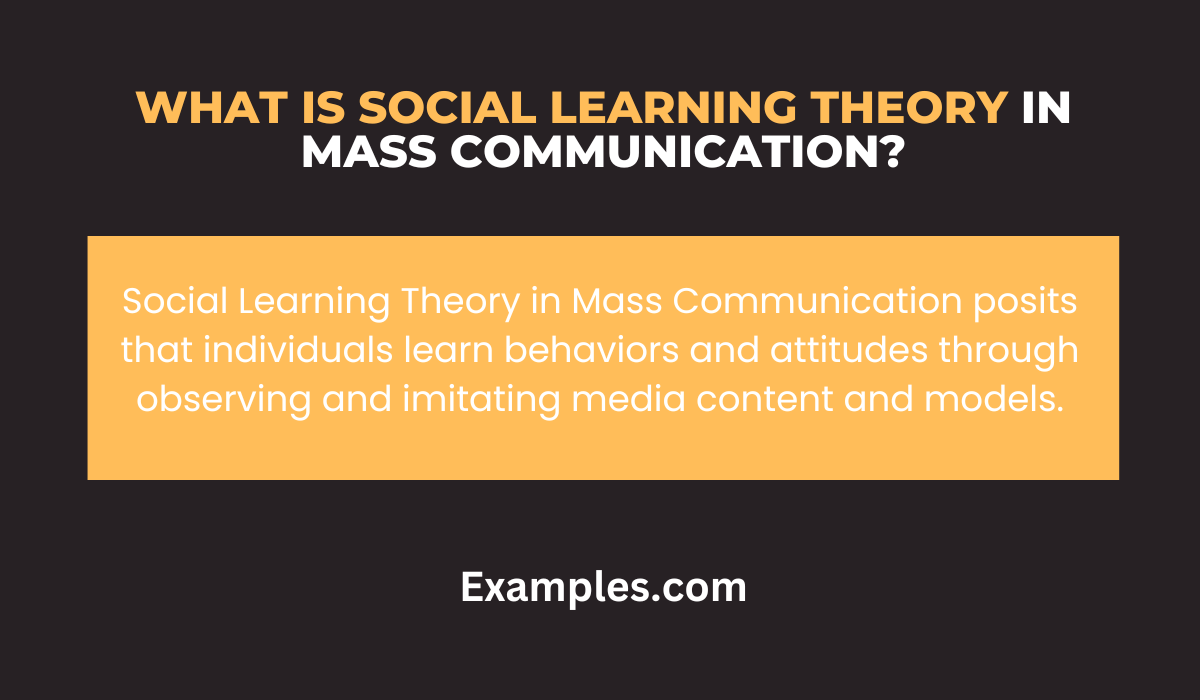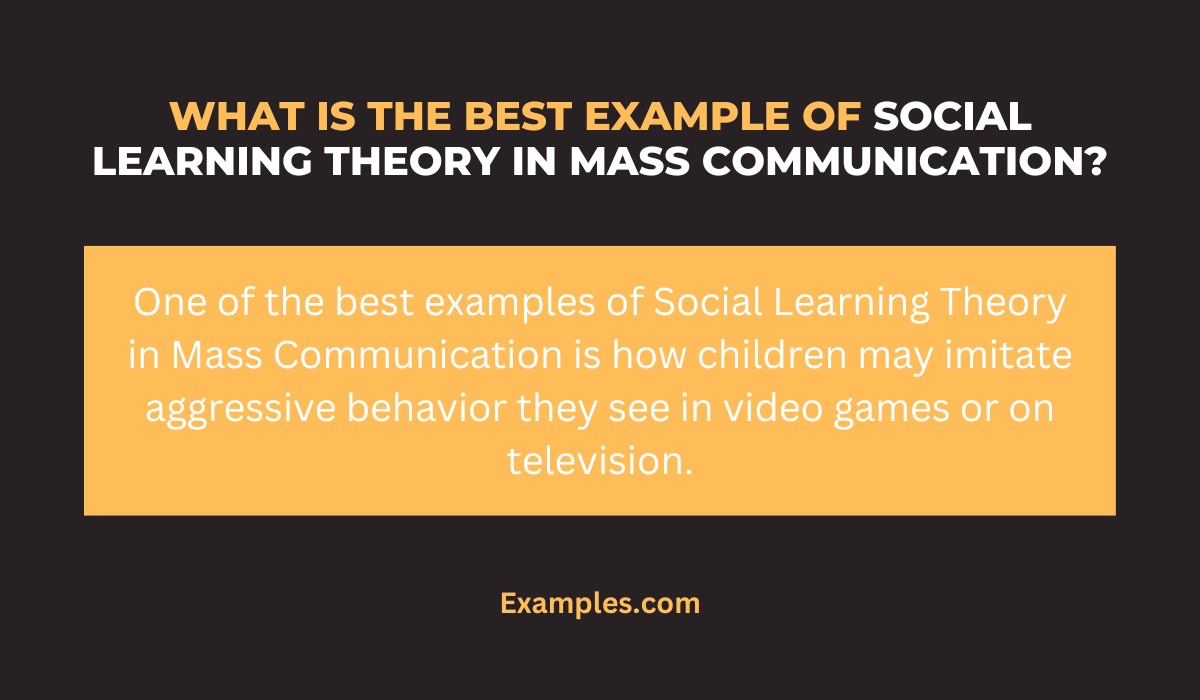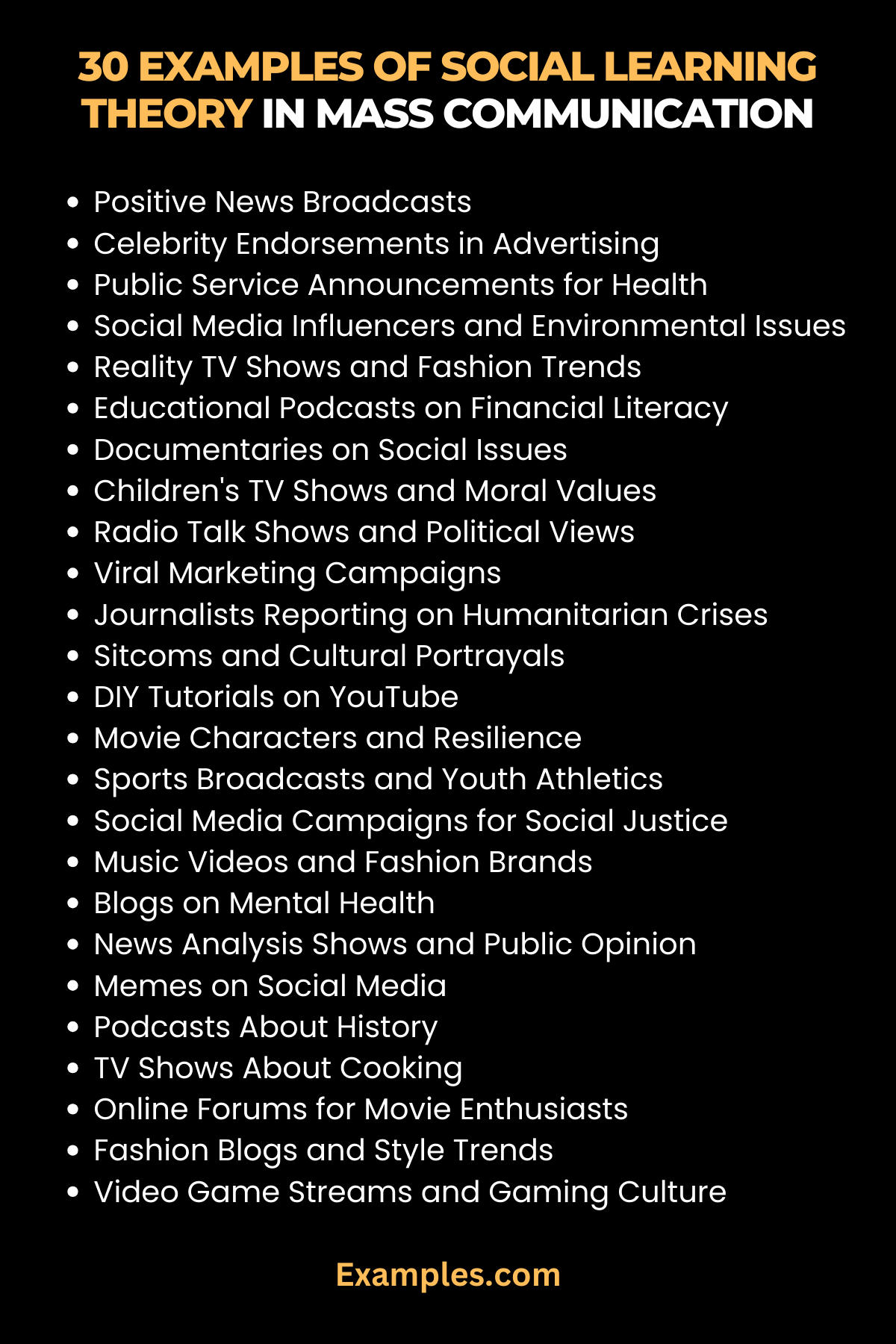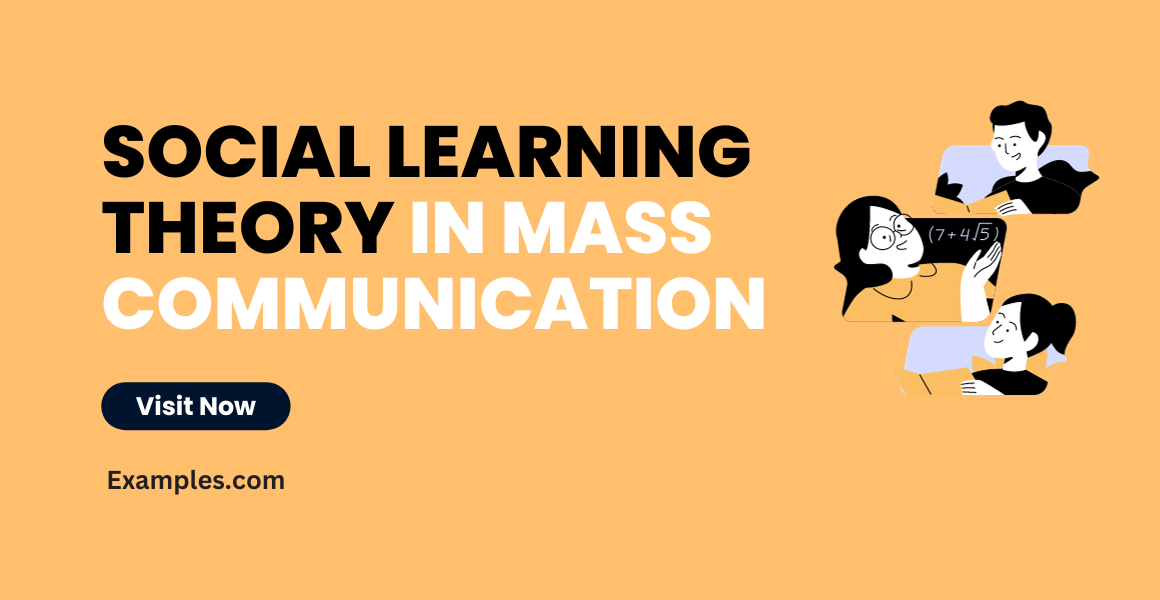29+ Social Learning Theory in Mass Communication Examples
Delve into the fascinating world of Social Learning Theory in Mass Communication. This comprehensive guide illuminates how media influences behaviors and attitudes in society. Packed with real-life examples, it’s a must-read for anyone interested in Mass Communication Characteristics, and how they shape our understanding of the media-saturated world.
What is Social Learning Theory in Mass Communication?
Social Learning Theory in Mass Communication explores the process by which individuals learn and adopt behaviors, attitudes, and emotions through observing others in media contexts. This theory underscores the significant impact that television, social media, and other mass communication forms have on societal learning and behavioral changes.

History
The Social Learning Theory, initially developed by psychologist Albert Bandura, has profoundly influenced the field of mass communication. This theory posits that people learn from observing others, especially in the context of media. It highlights the significant role of mass media in shaping behavior and social norms.
During the mid-20th century, as television and radio became more prevalent, researchers began to explore how these new forms of mass communication were influencing societal behaviors. Bandura’s famous “Bobo doll” experiment in the 1960s demonstrated that children imitated aggressive behavior they observed on television, thus solidifying the importance of Social Learning Theory in understanding mass media’s impact.
In the realm of mass communication, Social Learning Theory has been instrumental in explaining various phenomena. For example, it sheds light on how television and film can propagate stereotypes and influence public perception. Additionally, it has been pivotal in understanding the role of media in the socialization process, especially among children and adolescents.
With the advent of digital media, Social Learning Theory has found new applications. Platforms like social media have become powerful tools for observational learning, where influencers and public figures often set trends and norms.
The theory has also significantly impacted professional practices. In public relations and mass communication, understanding the principles of Social Learning Theory is crucial for crafting messages that positively influence public behavior and attitudes.
Moreover, the theory has influenced educational approaches in mass communication scenarios. It underscores the importance of responsible media production, as media messages have the power to shape societal attitudes and behaviors.
What is the Best Example of Social Learning Theory in Mass Communication?
A prime example of Social Learning Theory in action within Mass Communication is the influence of public service announcements (PSAs) on public behavior. For instance, anti-smoking campaigns on television effectively demonstrate the negative consequences of smoking, leading viewers to associate smoking with adverse health effects. This form of media communication not only informs but also alters viewers’ perceptions and behaviors regarding smoking, showcasing the potent role of mass media in shaping public health attitudes and practices.

30 Examples of Social Learning Theory in Mass Communication
Social Learning Theory in Mass Communication: This theory explores how media influences behavior and attitudes. It’s vital in understanding the impact of media on society, particularly in the digital age. Social Learning Theory highlights the importance of observational learning and the role of media as a powerful tool for shaping societal norms and behaviors. It’s essential for students, educators, and professionals in mass communication, providing insights into how media messages are received and internalized.

- A news broadcast showing positive stories – Inspires viewers to engage in similar positive actions.
- Celebrity endorsements in advertising – Demonstrates the influence of role models in shaping consumer behavior.
- Public service announcements promoting health behaviors – Uses media to encourage societal changes in health practices.
- Social media influencers discussing environmental issues – Shows the role of new media in spreading awareness.
- Reality TV shows influencing fashion trends – A prime example of media shaping public preferences.
- Educational podcasts on financial literacy – Media as a tool for spreading knowledge and influencing decisions.
- Documentaries on social issues – Raises awareness and inspires change through storytelling.
- Children’s TV shows teaching moral values – Highlights media’s role in early childhood learning.
- Radio talk shows discussing political views – Reflects how media can shape political opinions.
- Viral marketing campaigns – Demonstrates the power of media in creating trends.
- Journalists reporting on humanitarian crises – Media as a catalyst for public response and aid.
- Sitcoms portraying diverse cultures – Media’s role in promoting cultural understanding and acceptance.
- YouTube tutorials on DIY projects – Showcases media as a learning and skill development tool.
- Movie characters displaying resilience in adversity – Influences audience’s perception and behavior.
- Sports broadcasts inspiring youth athletics – Media’s role in shaping aspirations and hobbies.
- Social media campaigns for social justice – Demonstrates the mobilizing power of digital media.
- Music videos promoting fashion brands – A clear instance of media influencing consumer choices.
- Blogs discussing mental health – Media as a platform for destigmatizing and educating on sensitive topics.
- News analysis shows shaping public opinion – Reflects the interpretive role of media in society.
- Memes on social media creating cultural dialogue – Shows the lighter, yet impactful, side of media communication.
- Podcasts about history influencing learning methods – Media transforming traditional educational approaches.
- TV shows about cooking influencing culinary habits – Demonstrates media’s role in lifestyle changes.
- Online forums for movie enthusiasts – Showcases media’s role in community building and opinion formation.
- Fashion blogs setting trends – A modern example of media’s influence on personal style.
- Video game streams promoting gaming culture – Reflects the growing influence of interactive media.
- Webinars on career development – Highlights the educational and professional development aspects of media.
- Social media posts about travel influencing tourism – Shows the persuasive power of media in decision-making.
- Email newsletters for political campaigns – Demonstrates the strategic use of media in public relations.
- Billboard advertising for public awareness campaigns – A traditional yet effective form of mass media communication.
- Digital news platforms discussing global events – Shows how media connects and informs a global audience.
Role of Social Learning Theory in Mass Communication
Social Learning Theory, initially proposed by Albert Bandura, plays a pivotal role in mass communication. This theory suggests that individuals learn behaviors, attitudes, and emotional reactions through observing others, particularly in a media context.
- Modeling Behavior: Mass media often serves as a ‘behavioral model’. Audiences observe and imitate behaviors portrayed in media, such as television, films, and social media. This imitation can encompass both positive and negative behaviors.
- Shaping Social Norms: Media representations can shape what is perceived as normal or desirable within a society. Social Learning Theory explains how media can influence societal norms and expectations, especially among impressionable youth.
- Impact on Public Opinion: Through exposure to media, individuals can adopt attitudes and opinions that are frequently presented. This is particularly evident in political communication, where mass media can play a significant role in shaping political views.
Importance of Social Learning Theory in Mass Communication
Understanding the importance of Social Learning Theory in mass communication is crucial for creating effective media messages.
- Influencing Consumer Behavior: Advertisers and marketers use principles of Social Learning Theory to influence consumer behavior. By showcasing desirable lifestyles and behaviors, media can motivate audiences to purchase products or adopt certain behaviors.
- Educational and Informative Role: Educational programs and public service announcements leverage Social Learning Theory to impart knowledge and promote positive social behaviors, such as public health practices.
- Media Literacy and Critical Thinking: Awareness of Social Learning Theory is essential for fostering media literacy. It helps audiences understand how media content can influence their perceptions and encourages critical thinking about media messages.
How to use Social Learning Theory in Mass Communication
Applying Social Learning Theory in mass communication involves several strategies to effectively influence and educate audiences.
- Utilizing Influential Role Models: Media creators can use influential figures or characters as role models to communicate desired behaviors or attitudes. This is evident in mass communication examples in school, where role models are used to promote educational and social values.
- Creating Relatable Scenarios: Developing mass communication scenarios/situations that audiences can relate to enhances the impact of the media message. Relatable content can lead to stronger identification with the behaviors being modeled.
- Reinforcement and Repetition: Repeated exposure to certain messages in media reinforces learning. This is a common tactic in advertising and public health campaigns.
- Interactive Media Platforms: Leveraging interactive platforms, such as social media and online forums, encourages audience participation and discussion, further reinforcing the learning process.
- Feedback Mechanisms: Incorporating feedback mechanisms in media allows audiences to interact with content, providing a two-way learning process that is more engaging and effective.
Social Learning Theory plays a critical role in shaping the content and impact of mass communication. By understanding and applying this theory, media creators and communicators can craft messages that educate, influence, and engage their audiences effectively.
Understanding Social Learning Theory in the context of Mass Communication is crucial for effective media engagement. This guide not only provides valuable insights but also practical tips, preparing students and professionals alike for real-life applications in various communication fields.



